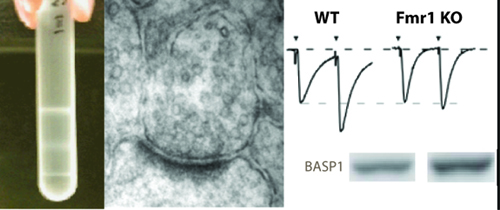
Fragile X syndrome, one of the most common inherited forms of X-linked mental retardation, is caused by a loss-of-function mutation of the Fmr1 gene on the X chromosome. The study, led by Patricia Klemmer and Dr Ka Wan Li in the neuroproteomics group at the VU University has just been published in the Journal of Biological Chemistry this month.
Fragile X syndrome, one of the most common inherited forms of X-linked mental retardation, is caused by a loss-of-function mutation of the Fmr1 gene on the X chromosome. The Fmr1 gene encodes the Fragile X Mental Retardation Protein (FMRP) which acts as an mRNA binding protein for many synaptic proteins in the brain. Using a genetically-engineered mouse model for Fragile X syndrome, we have been investigating the effects of FMRP’s absence upon synaptic proteins, synapse ultrastructure and physiology in the hippocampal brain region of young two-week old mice. The study, led by Patricia Klemmer and Dr Ka Wan Li in the neuroproteomics group at the VU University has just been published in the Journal of Biological Chemistry this month.
Previously, many of FMRP’s effects have been studied on the postsynaptic region of the synapse. This study shows some of FMRP’s actions on the presynaptic site during development of the hippocampus, a region that is important for spatial learning and memory. Using a proteomics approach to investigate how the absence of FMRP affected other synaptic proteins, the team found small but significant changes to two groups of proteins: one group known to be involved in cell differentiation and neurite outgrowth and a second cluster of proteins involved in synaptic vesicle release were upregulated in the Fmr1 KO mouse. Complementary to these changes in the synaptic proteome, electron microscopy revealed a more developmentally-immature appearance of synaptic structures in the same hippocampal region when FMRP was absent. Furthermore, the functional response of synapses in this region showed a distinct impairment in short-term plasticity that relies on the presynaptic physiology. Together, these data emphasise that lack of FMRP in the brain has effects on presynaptic structure, function and protein composition during hippocampal development. We are now investigating whether these changes persist during later stages of brain maturation in the Fmr1 KO mouse and how these changes may regulate other components of synaptic function.
